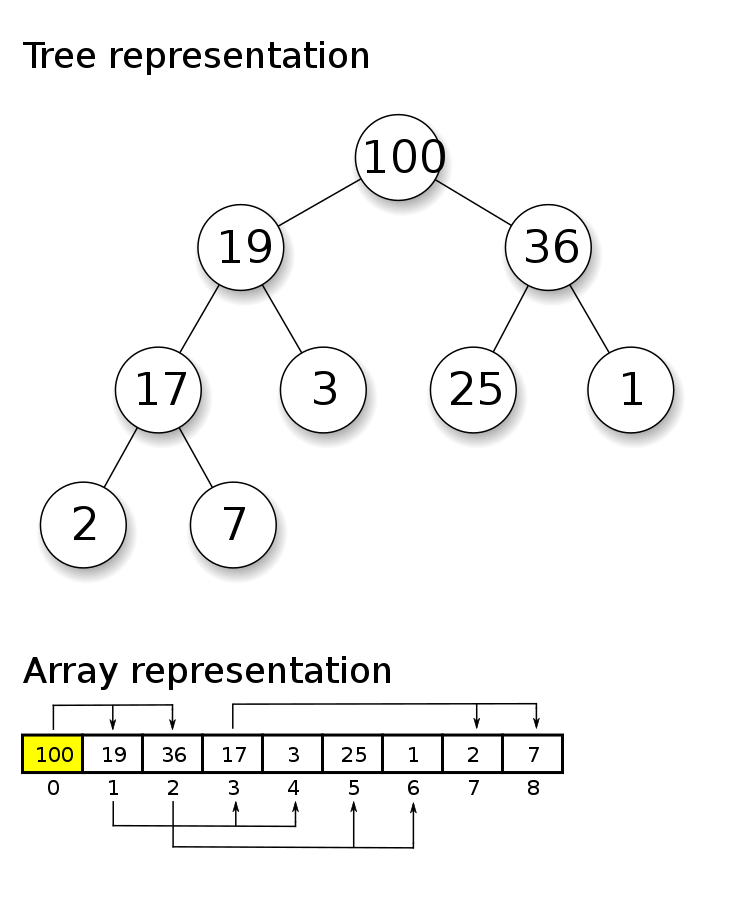12. Heaps
Feel free to use your laptop
You are strongly encourage to work with others
When you get stuck, ask those sitting around you for help
Get used to working together in the labs
Peer teaching and peer learning has been empirically shown to be very effective
Note
This topic has not been covered in lectures, but at this stage, this should not be a problem.
12.1. Heaps

A heap is encoded within an array but represents a binary tree structure. This particular heap is an example of a “max heap”, which is a heap where each node contains values larger than those of their children.
The root of the tree is always at index \(0\)
Given an element at index \(i\)
Its left child can be found at \(2i + 1\)
Its right child can be found at \(2i + 2\)
Assuming it’s not the root, it’s parent can be found at \(\lfloor (i-1)/2 \rfloor\)
\(\lfloor x \rfloor\) just means to round down if needed
For example, consider the element
17located at index \(3\) in the arrayLeft child would be at \(3*2 + 1 = 7\)
Right child would be at \(3*2 + 2 = 8\)
Parent would be at \(\lfloor (3-1)/2 \rfloor = 1\)
12.2. Min Heap
A min heap is a special heap with the property that the parent must be smaller than their children
Or, children of an element must be greater than their parent
In other words, the root must be the smallest element in the tree
This definition can be recursively applied to all subtrees within a tree
A max heap is similar to a min heap, but instead the root is the largest
The image above provides an example of a max heap
Warning
Although min/max heaps are binary trees, they are not binary search trees; do not get the idea of min/max heaps confused with binary search trees. Where binary search trees have the ordering based on left/right orientation, the min/max heaps have their ordering based on up/down direction.
12.2.1. Bubble Up
Whenever something is added to the heap, it is placed at the next available index in the array
This ensures that our heap is always a complete binary tree
However, if the goal is to make a min heap, simply adding something to the end may cause a problem since it may have a value less than its parent
Fortunately, there is a simple way to address this issue — Bubbling up
If the value at the index \(i\) is less than the value at the index of \(\lfloor (i-1)/2 \rfloor\) — its parent
Swap the values
Repeat this process for the inserted value until either
The inserted value is not less than the parent’s value
The inserted value is at the root
12.2.2. Bubble Down
Given the min heap’s property of the smallest element being at the root, it is often used for keeping track of ordered data
The minimum value in a collection is always at index \(0\)
Unfortunately, if the minimum value is to be removed, there will be no value at the root of the tree
A solution to this problem is to bubble down
Remove the element at the last index in the heap and place it in the root position \(i = 0\)
Compare the moved value with its left and right children at indices \(2i + 1\) and \(2i + 2\)
Swap the value with the smaller of the two children’s value
Repeat this process until either
The value is not greater than either child
There are no more children to compare to; the value is at a leaf
12.3. Implement a Min Heap
Create a generic
ArrayMinHeapclasspublic class ArrayMinHeap<T extends Comparable<? super T>>
Include fields to keep track of the size and the array containing the elements
Implement the following methods
addsizeremovepeek
Consider adding the following private methods
bubbleUpbubbleDownexpandCapacityparentOfleftChildOfrightChildOfswap
Test the heap to see if it is working properly
Simply create an instance of the
MinHeapand use the implemented methods to check correctnessFor the purpose of the lab, do not worry about writing full unit tests